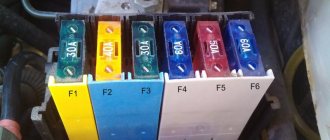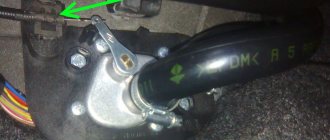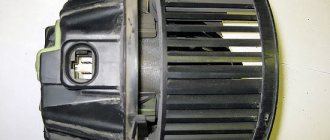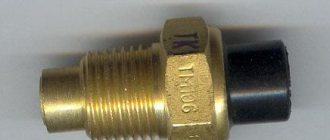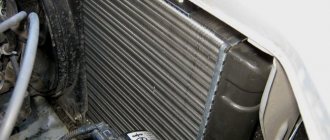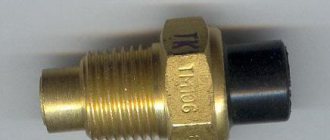December 18, 2015 Lada.Online 183 720 18
The stove on the VAZ 2121, 2131 has a number of advantages and disadvantages. One of them is associated with an electric fan, which not only blows weakly, but also makes a lot of noise and whistles during operation. Replacing it with a new type fan will solve only part of the problems. As practice shows, it is better to install an additional fan from the figure eight “snail” type.
The point of the modernization is to install on the Lada 4×4 an additional electric fan from the VAZ 2108, which will be located in the engine compartment inside the air intake, where it is normally positioned at figure eight. Let us remind you that the standard Lada 4×4 fan is located inside a plastic box in the cabin.
You will need: a figure-eight stove fan with a casing (catalog number: 2108-8101091).
The fan control can be left as standard, then there will be the least amount of modifications. Or use additional parts from the VAZ 2108:
- an additional heater resistor (article: 2108-8101081), which will need to be placed in the air intake next to the fan;
- fan speed switch (2108-3709608), which is mounted on a panel in the SUV interior.
Comparison of the VAZ 2121 stove and the VAZ 2108 stove! Connection diagram
In the cabin, unscrew 4 nuts using a 10mm wrench; Remove the air intake. Cut off part of the plastic a little from the side so that the fan housing does not interfere with the hood lock; Secure the fan, securing its housing with sealant. We close the space around the fan nozzle with suitable material to prevent air outflow; We install the casing with the fan in place, laying the wires; We check that the hood closes without problems. The result should be a design as shown in the video: The damper can be left, but if it is removed, there will be no additional obstacles to the flow of air into the cabin.
The easiest way is when the fan speed adjustment remains standard, but two speeds may not be enough. If you change the standard Niva switch to a figure eight switch and install an additional switch from it. resistor, then there will be three speeds! Diagram of such a connection: What was improved? Quiet, and at 1st speed silent. Productive, at speed 1 it blows at the level of speed 2 of the old fan. At maximum speed, dust will fly out of the air ducts. Such tuning of the heating system is mandatory for drivers of northern cities. Have you improved the Niva 4x4 stove in this way? Write reviews and additions on this modernization, take part in the survey. Let us remind you that other improvements to the SUV are published in.
The stove on the VAZ 2121, 2131 has a number of advantages and disadvantages. One of them is associated with an electric fan, which not only blows weakly, but also makes a lot of noise and whistles during operation. Replacing it with a new type fan will solve only part of the problems. As practice shows, it is better to install an additional fan from the figure eight of the snail type. The point of the modernization is to install on the Niva an additional electric fan from the VAZ 2108, which will be located in the engine compartment inside the air intake, where it is normally positioned at figure eight. Let us remind you that the standard Niva 4x4 fan is inside a plastic box in the cabin. You will need: a figure-eight stove fan with a casing (catalog number: 2108-8101091). The fan control can be left as standard, then there will be the least amount of modifications.
Or use additional parts from the VAZ 2108: an additional heater resistor (article: 2108-8101081), which will need to be placed in the air intake next to the fan; fan speed switch (2108-3709608), which is mounted on a panel in the SUV interior. In the cabin, unscrew 4 nuts using a 10mm wrench; Remove the air intake. Cut off part of the plastic a little from the side so that the fan housing does not interfere with the hood lock; Secure the fan, securing its housing with sealant. We close the space around the fan nozzle with suitable material to prevent air outflow; We install the casing with the fan in place, laying the wires; We check that the hood closes without problems. The result should be a design as shown in the video: The damper can be left, but if it is removed, there will be no additional obstacles to the flow of air into the cabin.
The easiest way is when the fan speed adjustment remains standard, but two speeds may not be enough. If you change the standard Niva switch to a figure eight switch and install an additional switch from it. resistor, then there will be three speeds! Diagram of such a connection: What was improved? Quiet, and at 1st speed silent. Productive, at speed 1 it blows at the level of speed 2 of the old fan. At maximum speed, dust will fly out of the air ducts. Such tuning of the heating system is mandatory for drivers of northern cities. Have you improved the Niva 4x4 stove in this way? Write reviews and additions on this modernization, take part in the survey. Let us remind you that other improvements to the SUV are published in.
What did you improve?
The modernized stove has a number of advantages:
- Quiet, and at 1st speed silent.
- Productive, at speed 1 it blows at the level of speed 2 of the old fan. At maximum speed, dust will fly out of the air ducts.
Such tuning of the heating system is mandatory for drivers of northern cities. Have you improved the Niva 4x4 stove in this way? Write reviews and additions on this modernization, take part in the survey. Let us remind you that other modifications to the SUV are published in this category.
Photo: Flea in-flight magazine
Keywords: Niva stove | Niva air ducts
Found an error? Select it and press Ctrl+Enter..
Heater VAZ 2121, 21213, 21214, 2131 modernized, in collection. with body
The heater is designed for installation on VAZ 2121, 21213, 21214, 2131, Lada 4×4 cars.
The heater is a plastic housing with a built-in electric motor and air blower.
It has a number of advantages over a standard heater:
- The motor is easy to install. Practical silent operation.
- Three-position switch.
- Increased heating speed and air flow into the cabin.
The serial motor with a fan in the cabin can be removed (removal/installation steps are carried out in accordance with routine maintenance), but if you want to have a spare option, you can leave it. In this case, the old motor with an impeller will provide some resistance to air movement
Heater assembly Airflow mode switch Wiring harness Fasteners Air flow distributor
1. The serial motor with a fan in the cabin can be removed (removal/installation steps are carried out in accordance with routine maintenance), but if you want to have a spare option, you can leave it. In this case, the old motor with the impeller will provide some resistance to air movement. 2. If desired, the standard heater can be kept in working order as a backup. In this case, it will be necessary to connect an additional positive wire to the new heater and take into account that the simultaneous operation of both heaters will create an increased load on the vehicle’s on-board electrical network, which is extremely undesirable.
By clicking on the button you will receive all the information on delivery and payment of the method convenient for you to receive the goods. Our employees will calculate for you the most profitable method of delivering the goods you have chosen.
Pickup for everyone who is convenient in Moscow to independently pick up and pay for the goods you have chosen.
Delivery by mail or EMS Post. It is preferable for buyers who live in areas where there are no branches of transport companies nearby. Some goods can be sent by mail (restrictions on weight and dimensions). We will advise you on a more convenient delivery method.
Replacing the faucet
Proper installation of a gas system with your own hands on a Chevrolet Niva
There is one more element in the design of the Niva’s heating system that significantly reduces its performance. This is the stove faucet. It has a small cross-section, which in turn significantly slows down the circulation of antifreeze in the system, which is why the stove needs more time to warm up. Replacing this faucet will help improve the situation. The best option is to install this element from a foreign-made car. Heater taps from some Opel or Volkswagen models have proven themselves well.
The faucet is replaced as follows:
- It is necessary to open the hood and get close to the heater hose in the engine compartment, then loosen its clamp and remove the hose from the pipe.
- We unscrew the screws that secure the seal to the plane of the partition.
- Remove the sealant layer by first prying it off with a screwdriver.
- The glove compartment is removed.
- It is necessary to loosen the screw that secures the faucet by approaching it from the interior.
- There is a control cable on the crane lever; it must be removed.
- Depending on the design of the Niva-21213 stove, its body can be secured with two nuts or two screws.
- The new heater tap is installed on the car in the reverse order.
We emphasize that in the case of a screw fastening of the stove faucet to the heat exchanger, this procedure is somewhat problematic, since the nuts constantly fall out. To do this, they simply need to be secured with plasticine or chewing gum. In addition, it is worth adjusting in advance the cable that controls the position of the heater tap. If this is neglected, then during the operation of the stove you will have to constantly climb under the dashboard in order to set its position.
Heater snail from 2108 on Niva 2121, VAZ 2131
How to change the radiator of a VAZ 2114 (2115) stove with your own hands
Do-it-yourself tuning of the Niva 2121 interior, tips for modifying the interior, internal tuning of the Niva 2131, VAZ 2121. Tuning VAZ cars is an increase in the factory characteristics of the car. Refinement of the Niva 2121 is, first of all, the installation of new bumpers, crankcase protection, and a winch.
If desired, the owners of these SUVs install additional fog lights. Our sections describe instructions and tips for modifying the Niva 2131 of various units, such as the transfer case, etc. Even a car enthusiast can do complex tuning of vases with his own hands.
You will also find categories for engine tuning, gearbox tuning, interior and exterior tuning, as well as many photo reports of VAZ 2121 tuning. Thanks to interesting solutions, Niva tuning will give you a lot of pleasure and benefits.
If you have photos of tuning vases, send them to us by email.
The stove in Niva is frankly bad! One of its most important problems is the fan itself, which is installed under the radiator, and also vertically. Hot air passing through it heats it up greatly and all the lubricant gradually drains from the rotor.
As a result, the motor starts to squeal! Probably everyone knows this problem! Well, productivity there is generally zero... The problem is solvable! We install the “snail” from the VAZ-2108 and get increased productivity, silence, and, if desired, three control speeds. The idea is not new, I borrowed it from other sites.
But everyone does it in their own way - this is how I did it...
- With all this, after remaking the stove motor, you can’t hear the stove at all, since the motor itself is now located in the engine compartment!
- We completely disassemble the entire heater!
If you want to have three speeds, we embed a heater resistor from a VAZ-2108/M2141 into the lower part of the body, on the driver’s side.
We glue all the joints of the body, and especially the installation location of the VAZ 2121 radiator, with a rubber seal (available in any hardware store)
We assemble the lower part, the VAZ 2131 engine with the fan is simply thrown out from there! We don't need him anymore!
We disassemble the upper part of the heater, remove the grille from the air intake of the Niva 2121...
And carefully, with minimal gaps, we cut out a place for the “snail” from the VAZ-2108. We install it as shown in the photo (bottom view)
We fill the remaining cavity with polyurethane foam! Then, after hardening, we cut it flush with the bottom of the air intake housing.
This is what the Niva 2131 air intake should look like!
We put on the seal and install it under the hood!
Recommendations from specialists for upgrading the stove with VAZ parts
Installation of VAZ parts should be carried out subject to the following rules:
- It is necessary to make the mounting socket for the new part 2 centimeters larger to reduce the vibration load.
- The installation of the tap must be carried out taking into account the specifics of the VAZ heater. In this case, there will be fewer problems with this part.
If, while dismantling the old stove, you notice that it has significant wear, then it is best to replace the unit completely. In a seemingly intact “snail,” only the engine needs to be replaced. Disassemble the case carefully to avoid damaging it. Replacing the heater motor is the most time-consuming procedure. You will not need to adjust the stove body to the size of the snail.
Fan replacement
Do-it-yourself modification of the Priora stove
The main reason for the low temperature in the car is the poor performance of the heater fan, which forces warm air through it into the cabin. In addition, being directly inside the car, it operates quite loudly at high speeds and whistles unpleasantly, especially in winter. Therefore, it is replaced with a fan from a VAZ-2108 (“eight”) car, which together with the casing is often called a “snail”. Their sizes differ slightly, so installing a new one is quite simple, with minor design modifications. Place the fan in the engine compartment, inside the air intake. This significantly reduces the noise from it. The heater radiator shutter needs to be removed.
They place it inside the air duct, since it needs airflow.
The cross-section of the wires suitable for it needs to be increased, since the new motor consumes more power.
The outer openings for air passage in the hood must be sealed to reduce the flow of cold air through them to the stove by half.
heater Snail from 2108 on Niva 2121, VAZ Tuning
2131 Niva 2121 interior with your own advice, manual modification of the interior, internal tuning of 2131 Niva, VAZ 2121. Car tuning is VAZ increasing the factory characteristics of the car. Niva Revision 2121 is, first of all, the installation of new bumpers, crankcase protection, and a winch.
At the request of the owners of these SUVs, additional fog lights are installed. Our sections describe instructions and modifications for advice on Niva 2131 of various units, such as the transfer case, etc. Even a car enthusiast can do complex tuning of vases with his own hands.
You will also find categories for engine tuning, gearbox tuning, interior and body tuning, as well as photos and many reports on VAZ 2121 tuning. Interesting Thanks to the solutions, Niva tuning will bring you a lot of pleasure and benefits.
If you have photos of tuning vases, send them to us at Pechka.
mail in Niva is frankly bad! One of the most important problems is the fan itself, which is installed under the radiator, and what’s more, vertically. Hot air passing through it greatly heats it up and all the lubricant gradually drains from the rotor.
As a result, the motor begins to squeal! Probably everyone knows this problem! Well, the productivity there is generally zero... The problem can be solved! We install the “snail” from the VAZ-2108 and we get increased productivity, silence, and, if desired, three speed controls. The idea is not new, I borrowed it from other sites.
Only everyone does it in their own way - just like I did...
- With all this, alterations after the stove motor are not heard at all, as the motor itself is now located in the engine compartment!
- We completely disassemble the entire heater!
If you want to have three speeds, we insert a VAZ resistor from the stove-2108/M2141 into the lower part of the housing, on the driver’s side
All joints especially, and the housing where the VAZ radiator is installed, we glue with 2121 rubber seal (available in any hardware store)
We assemble the lower part, we simply throw out the 2131 VAZ engine with a fan from there! We don't need him anymore!
We disassemble the upper part and remove the heater grille from the air intake of Niva 2121...
And with minimal gaps, we cut out a place for the VAZ from snail-2108. We install it as shown in the photo (bottom view)
We fill the remaining installation cavity with foam! Then, after hardening, we cut it flush with the lower part of the air intake housing.
This is what the Niva 2131 air intake should look like!
We put on the seal and install it under the Source!
hood: https://vazclub.com/niva/2131-2121/tyuning/salona/ustanovka-novoi-otopitelya-ulitki.html
Improvement No. 1. We take air from the cabin
The main disadvantage of the Niva heater is that all the air into the heater radiator comes from the street, and when the air intake flap is closed, air circulation and heating stop completely. To eliminate this drawback, I disassembled the heater (I had to drain some of the antifreeze and disconnect the heater radiator pipes), and in the side wall of the heater housing, opposite the wall where the radiator tubes exit, I made a hole in the shape of a rectangular trapezoid. I did it in such a way that there was 1.5-2 mm of the body wall left to the boundaries of the plane in which I made the hole, and 6-8 mm from the side of the stiffener for attaching the petal valve. I made the hole using a drill, marked it, drilled along the contour of the small diameter holes, then connected the holes using a knife, then filed the edges of the resulting hole, giving it its final shape. The area of the resulting hole was approximately 25 square centimeters. It is through this hole, when the heater air intake flap is closed, that air is drawn from the passenger compartment.
Since the salon is a closed space, air circulation occurs in a closed circle, and the warming up air of the salon, passing through the heater radiator, becomes increasingly hotter at the exit. Despite the small size of the hole, due to the absence of a supply of icy air from the street, the time for warming up the interior to a comfortable temperature and melting icy glass is reduced by 4-5 times, and it is possible to achieve a comfortable temperature even in severe frost.
To prevent cold air from entering the cabin through the hole when the air intake flap is open and the heater fan is turned off, a petal valve is installed on the hole on the inside of the heater housing, which does not interfere with air intake from the cabin. The petal valve is a rubber band cut from a car chamber (preferably from a truck), 1.5-3 mm thick, in the shape of a hole, but slightly larger, and attached to a bolt in such a way that it can freely bend inside the heater body, opening the access of air from interior, and fit snugly against the wall of the heater housing, blocking the hole for the passage of cold air into the cabin, past the heater radiator.
Read more: Where can you change hryvnia in Moscow
Improvement No. 3. Installing the grille on the air intake
When disassembling the heater, a large number of tree leaves and insect remains were found in the air intake casing and in the honeycombs of the heater radiator grille, which also reduced the efficiency of the heater. Therefore, after cleaning and flushing the heater core, I took measures to prevent the radiator from clogging.
To do this, I bent a wire frame to the size of the air intake inlet, covered it with a nylon mesh with a 1x1 mm cell, and installed it at the bottom of the rubber seal of the air intake inlet. It was perfectly fixed there in the fold, like an accordion, without additional fastening.
Fault Diagnosis
The stove supplied as standard will need to be modified for preventive purposes. The procedure will not take much time, but it will prevent many problems in the future. Driving experience suggests that the first severe frosts will undermine the “health” of the device. The list of main weaknesses is as follows:
- the optimal operating temperature range for model 2121 is from -5 to +10°C;
- inability to warm up the air in the cabin if outside is -8°C or lower;
- when the blowing power increases, the temperature does not increase;
- When driving in 2nd gear, the noise from the Niva's stove becomes significant.
That is why it is better to take the necessary measures in advance. The driver has few alternatives. On the one hand, everything remains in its place. The heating device is used at minimum power. During mild winters this is still tolerable, but with the onset of real cold weather the conditions will become unbearable. On the other hand, it's easy to spend a few hours rectifying the situation.
Further developments proceed as follows. If the heating in the car is running at ½ power, you can limit yourself to minor repairs. The main thing is to make sure that there are no noises or extraneous knocks, otherwise the Niva 21213 should immediately go for a technical inspection.
The presence of an unpleasant sound indicates the need to replace the device. A specialized retail network offers ready-made options for heating mechanisms for Niva. If desired, it can be assembled independently.
The second option is considered more preferable. When you assemble it yourself, you have the opportunity to literally personalize the stove. To do the work yourself, you will need to visit a specialized store or market to buy spare parts.
When purchasing, original parts or analogues are selected. The main thing is that they have a quality certificate. Otherwise, they cannot be installed. It would be useful to rewrite the technical data of the vehicle so as not to exceed the parameters recommended by the manufacturer.
Original parts vs analogues: practical advice
As mentioned earlier, such a choice does not affect the quality of the heating system. At the same time, car mechanics make several reservations. For those who plan to use VAZ stoves, it would be useful to check the power system. It is different for some modifications. That is why all actions are consistent with the drawings.
It is permissible to use the VAZ 2108 heater, provided that two recommendations are followed. Firstly, the mounting socket is 1-2 cm larger than the size of the device. The additional area will reduce the vibration impact. Secondly, the switch is installed taking into account the specifics of the VAZ heating system. You will have to tinker less when minor modifications to the system are needed.
The ventilation system is updated in 1-2 hours, depending on the degree of wear of the engine.
If the factory-installed “snail” has no signs of physical wear, you only need to replace the heater “engine” itself.
It’s worse if the factory equipment of a Chevrolet model has manufacturing defects. A complete replacement of the device is recommended. This will save time.
The operation of the heating system determines the comfort and safety of driving. The driver constantly monitors the system's performance. If extraneous noise appears, it is necessary to urgently carry out a technical inspection.
Fan installation
The problem of heater efficiency largely depends on poor fan operation. Many car enthusiasts, when tuning the stove, install a fan from 2108 on it. It fits almost perfectly, only minor modifications are required. In the simplest version, the standard control of the stove is left. But, you can also put “eight”.
In this case, in addition to the fan with a casing, you will need:
- Fan speed switch from 2108. This part is attached to the interior;
- Additional resistor for the stove. It is installed next to the fan.
- Having collected everything necessary, we begin the main operation of upgrading the stove:
- To remove the air intake box, you should unscrew 4 10mm nuts in the cabin. The easiest way to do this is with a wrench. In this case, an assistant must hold the corresponding screws under the hood;
- The air intake is removed from its seat;
- A little plastic is cut off from the case, this is done so that nothing interferes with the new fan;
- We install the fan;
- We remove all parts of the fan protruding beyond the body of the “boot”;
- All that remains is to secure the fan. Be sure to use sealant;
- The entire space around the fan nozzle must be covered with any material that will prevent air leakage to the side;
- The casing assembly with the fan is installed in place. Wires are connected to it. When installing, make sure that the new design does not interfere with closing the hood.
If desired, we install new controls. After all work has been completed, tests must be carried out. If everything is done correctly, the stove should work normally. The air flow should be significantly stronger than before.
Improvement No. 2. Increasing fan performance
I also slightly increased the efficiency of the standard heater fan. The fact is that the gap between the fan blades and the diffuser is about 3 mm, and the width of the diffuser is no more than 15 mm, while the width of the fan blades is more than 30 mm. Therefore, some of the air leaks back between the blades and the diffuser, preventing a large pressure difference from being created between the suction area and the discharge area.
To eliminate these shortcomings, I reduced the gap between the diffuser blades and lengthened the diffuser. I solved these problems by cutting out a strip 30 mm wide and equal to the circumference of the diffuser from an old plastic fender liner 1 mm thick. I inserted the bent end-to-end ring from this strip tightly into the diffuser and “sewed” it to the diffuser with a thin wire through the drilled holes, so that the fan blades did not cling to the strip or wire. Against the blowing windows, the width of the strip is trimmed to 20-25 mm.
According to my estimates, the efficiency of the fan increases by 10-15%, so you don’t have to bother with this problem.
Stove modernization
To upgrade the stove on your Niva, we suggest that you borrow, first of all, a VAZ-2108 stove fan. We do not recommend installing it instead of what is already installed on your Niva; by the way, you are unlikely to succeed, since it is located inside the car. It will be problematic to introduce a fan from 2108 into the cabin, so they find a more suitable space for it in the engine compartment. Upgrading the stove involves installing an additional fan, which is what we suggest you do.
We also recommend that you immediately decide whether you only want to install an additional fan or additionally borrow its speed switch and heater resistor from the G8.
Fan replacement algorithm
Initially, we suggest that you remove the air intake box, which in the driver’s environment also has another popular name: “boot”. It is not very convenient to remove it yourself, so we recommend that you involve your friend in performing this procedure. The inconvenience is that the nuts need to be unscrewed while in the cabin, and the bolts themselves must be held from the engine compartment. Your free hand will certainly not reach the engine compartment. After all the nuts are unscrewed, remove the air intake.
Now you have to perform some manipulations to remake the removed air intake, and then install a figure-of-eight fan into it. Otherwise, you will not be able to close the hood because the fan will interfere with the lock.
So, you need to cut off the plastic on the side of the air intake, and on the fan itself - the fastening parts protruding to the sides. Once the fan is perfectly located in the internal space of the air intake, secure it with sealant. Place suitable material around the fan nozzle. This will allow you to eliminate loss of air outflow. Now install your upgraded fan shroud and try closing the hood.
Motor replacement algorithm
It would be useful to consider the issue of installing a stove motor borrowed from the G8. In this case, it will also be possible to significantly improve the operation of the stove. The removed figure-eight motor also needs to be initially tried on in the air collector, and if necessary, cut out additional space with a grinder so that it can successfully fit in it. After you make sure that it fits properly, we recommend fixing the motor with sealant to eliminate possible vibration while driving the car. Of course, the original engine should be thrown away and all the wires should be connected to the mechanism you just installed.
After you have upgraded the heater, we suggest that you also install an additional “figure-of-eight” resistor, which will allow you to increase the number of speeds to three. You need to install the resistor next to the fan you installed earlier. These actions allow you to perfectly regulate the rate of supply of warm air, providing quick or gradual heating of the interior.
So, if you carefully study in advance the connection diagram for the fan, resistor, and motor borrowed from the domestic G8, you will be satisfied with the result of your own work. You simply won’t recognize your car, since the interior will instantly warm up, increasing the level of comfort for the driver and passengers.
International NIVA Club
Forums
| Photo gallery | NIVA-SHOP | Files | Video |
- List of forumsAuto - EquipmentTechnical section Lada 4x4 NivaGeneral technical
- Search
Links
- Unanswered topics
- Active topics
- Search
Troubleshooting
The Chevrolet Niva stove is one of the most problematic components of the car. To carry out quality repairs, you first need to understand the reasons and identify the faulty element of the system.
The heater does not heat the footwell
There may be several reasons why the stove does not direct air to the legs. First you need to find out whether this mode is turned on correctly. Due to the design features of the damper system, air is directed to the legs as follows:
- Warm up the engine.
- Set the stove fan speed to fourth.
- Set the heater mode switch to the upper vertical position.
- Switch the mode controller one position to the left.
After this, air should begin to flow into the legs. If this does not happen, the procedure should be repeated several more times. If the mode still does not turn on, you should check the following components:
- electric motor of the stove (if it is faulty, the stove will not work);
- radiator and heater pipes for coolant leaks;
- a damper that distributes air flows;
- the entire air duct system for leaks.
Coolant leak
If antifreeze leaks from the cooling system without visible streaks on the radiator and pipes, you need to pay attention to the condition of the heating system. The main signs of coolant leakage through the stove are:
- reduction in heating efficiency;
- coolant smell when the stove is operating;
- puddles of antifreeze on and under the mats;
- oily coating on the inside of the glass.
Typically the leak occurs through the heater core. To verify this, you need to remove the lower part of the center console. If traces of moisture are detected in the area of the stove body, it is recommended to replace the radiator.
If a coolant leak is detected through the heater radiator, it should be replaced
Before replacing the heater radiator, you should check the tightness of the heater pipes and their connections.




